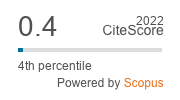Studies on the nuclear polyhedrosis of Pericallia ricini F. (Lepidoptera : Arctiidae)
DOI:
https://doi.org/10.33307/entomon.v1i1.1115Abstract
Studies on the nuclear polyhedrosis of the larvae of Pericallia ricini F. (Arctiidae) revealed that the infected larvae exhibited all the typical symptoms of nuclear polyhedrosis. Caterpillars of second, third and fourth instars were highly susceptible, those of the fifth instar moderately so and those of sixth instar highly resistant to the infection. The total haemocyte count decreased in the virus-infected larvae progressively from 48 hours after ingestion of the virus. The polyhedra measured 1284.6 ± 12.48 mµ in diameter. They were completely soluble in weak solutions of NaOH, KO and Na2CO3. The thermal inactivation point of the virus was between 900 and 950C. Exposure of the polyhedra to direct sunlight for 96 hours substantially reduced its infectivity. But it remained highly infectious after exposure to 350C in an oven for 96 hours, though in 120 hours it lost its infectivity. It thus appeared that in addition to temperature, perhaps light was also responsible for deactivation of the virus under field conditions. The virus was not infective to four species of alternate caterpillars tested.
Downloads
Published
How to Cite
Issue
Section
License
Copyright (c) 2024 Association for Advancement of Entomology

This work is licensed under a Creative Commons Attribution-ShareAlike 4.0 International License.


